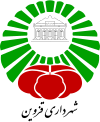Qazvin
|
Qazvin قزوین |
||
|---|---|---|

Shazdeh Hosein shrine
|
||
|
||
| Coordinates: 36°16′N 50°00′E / 36.267°N 50.000°ECoordinates: 36°16′N 50°00′E / 36.267°N 50.000°E | ||
| Country |
|
|
| Province | Qazvin | |
| County | Qazvin | |
| Bakhsh | Central | |
| Government | ||
| • Mayor | Ramin Soltanzadeh | |
| Elevation | 1,278 m (4,193 ft) | |
| Population (2011) | ||
| • Total | 381,598 | |
| Time zone | IRST (UTC+3:30) | |
| • Summer (DST) | IDST (UTC+4:30) | |
| Area code(s) | 028 | |
| Website | www |
|
Qazvin (/kæzˈviːn/; Persian: قزوین, IPA: [ɢæzˈviːn], also Romanized as Qazvīn, Caspin, Qazwin, or Ghazvin) is the largest city and capital of the Province of Qazvin in Iran. Qazvin was an ancient capital in the Persian Empire and nowadays is known as the calligraphy capital of Iran. It is famous for its Baghlava, carpet patterns, poets, political newspaper and pahlavi (Middle Persian) influence on its accent. At the 2011 census, its population was 381,598.
Located in 150 km (93 mi) northwest of Tehran, in the Qazvin Province, it is at an altitude of about 1,800 m (5,900 ft) above sea level. The climate is cold but dry, due to its position south of the rugged Alborz range called KTS Atabakiya.
The city was a capital of the Persian Empire under Safavids in 1548-1598. It is a provincial capital today that has been an important cultural center throughout history.
Archeological findings in the Qazvin plain reveal urban agricultural settlements for at least nine millennia. Qazvin geographically connects Tehran, Isfahan, and the Persian Gulf to the Caspian seacoast and Asia Minor, hence its strategic location throughout the ages.
...
Wikipedia


